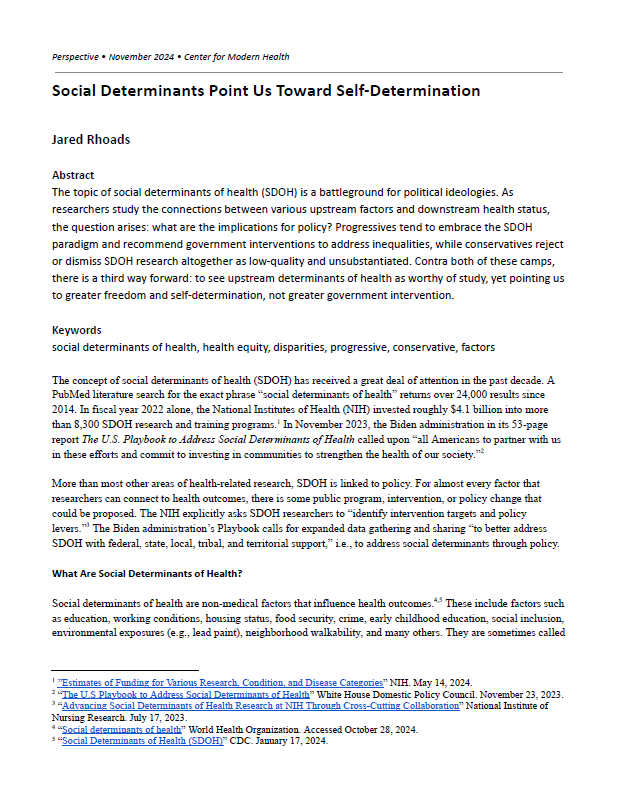Social Determinants Point Us Toward Self-Determination
Upstream determinants point us toward greater freedom and self-determination, not greater government involvement in people's lives.
View/Download [PDF]
Rhoads, J. "Social Determinants Point Us Toward Self-Determination." Center for Modern Health. November 2024.
The concept of social determinants of health (SDOH) has received a great deal of attention in the past decade. A PubMed literature search for the exact phrase "social determinants of health" returns over 24,000 results since 2014. In fiscal year 2022 alone, the National Institutes of Health (NIH) invested roughly $4.1 billion into more than 8,300 SDOH research and training programs.1 In November 2023, the Biden administration in its 53-page report The U.S. Playbook to Address Social Determinants of Health called upon "all Americans to partner with us in these efforts and commit to investing in communities to strengthen the health of our society."2
More than most other areas of health-related research, SDOH has implications for policy. For almost every factor that researchers can connect to a health outcome, there is some program or intervention that could be proposed. The NIH explicitly asks SDOH researchers to "identify intervention targets and policy levers."3 The Biden administration's Playbook calls for expanded data gathering and sharing "to better address SDOH with federal, state, local, tribal, and territorial support," i.e., to address social determinants through policy.
What Are Social Determinants of Health?
Social determinants of health are non-medical factors that influence health outcomes.4,5 These include factors such as education, working conditions, housing status, food security, crime, early childhood education, social inclusion, environmental exposures (e.g., lead paint), neighborhood walkability, and many others. They are sometimes called "the conditions in which people are born, grow, live, work, learn, pray, play, and age."6 The definition is broad and the list of factors is continually expanding. Newer additions include exposure to school bullying, access to parks, the presence of bike lanes in a community, and experiences of medical discrimination.7,8
To bring order to this growing list, frameworks like Healthy People 2030 from the U.S. Department of Health and Human Services (HHS)9 categorize SDOH into five domains: 1) Educational access and quality, 2) Health care access and quality, 3) Neighborhood and built environment, 4) Economic stability, and 5) Social and community context.
Some factors, such as income, are arguably not "social" in nature but are nevertheless included.10 It seems to be the case that almost anything can be considered a social determinant, as long as it is associated with a perceived "health inequity," which is to say a differential health outcome that is seen as "unfair."11
Social Determinants and Political Progressives
Progressives generally embrace SDOH as evidence that social and economic policies systematically influence health disparities. As a 2010 report from the Robert Wood Johnson Foundation puts it, "For Democrats, health is itself a right; all Americans have the right to health care and the right to lead a healthy life. One Democrat states, 'Health care is a right, it's so fundamental to being able to have a healthy lifestyle.'"12 Addressing upstream factors through government various programs, initiatives, and subsidies aligns with this worldview. This view supports leveraging government to address determinants such as housing, food security, childcare, and neighborhood walkability. It would also be consistent to argue that the government must forgive educational and medical debt on the grounds that it would improve health by alleviating financial stress, or to declare that every neighborhood should have a playground for the mental and physical health of children.
How far should the government go in engineering our life circumstances and surroundings? No clear limiting principle is ever offered. Indeed, for progressives, the more steadfast the commitment to "health equity," the more ambitious the involvement should be.
Social Determinants and Political Conservatives
Conservatives approach the social determinants paradigm with skepticism. Some object to the framing of health outcomes as being driven by societal factors, to the minimization and exclusion of individual choice. Conservatives see individuals as the authors of their own health journeys, each either benefiting from the good choice that they might make on their journey, or being responsible for the negative consequences from bad choices that they might make.13 Again, the Robert Wood Johnson Foundation: "This long-term journey frame makes Republicans more hesitant to institutionalize programs to address social determinants of health, particularly in a federal government that is slow to adapt to unforeseen, yet inevitable changes over time."
Many conservatives object to the SDOH project on the grounds of insufficient evidence. They seize upon the fact that much SDOH research relies on relatively low-quality observational studies that are prone to methodological problems such as selection bias, reporting bias, and confounding. Also, many of the interventions that have been deployed to study the feasibility of addressing SDOH are short-term and small in scale. Large-scale trials remain rare. Conservatives call out SDOH proponents for making poorly supported claims about the role that social factors play—for instance that SDOH factors are responsible for up to 80 percent of health outcomes.14,15 This and the redistributionist policy recommendations in SDOH writings leads many conservatives to reject SDOH as just another progressive project.
A Third Perspective
Rather than rejecting SDOH for its current empirical weaknesses (the way conservatives do) or regarding it as justifying expanded government (the way progressives do), a third perspective recognizes its potential value while advocating for a different interpretation of its policy implications. This perspective reframes the discussion in two key ways:
Step 1: Recast "social" to "upstream"
The term "social" in SDOH is vague and politically loaded. Replacing it with "upstream" better captures the legitimate observation that non-medical factors influence health without biasing the discussion toward there needing to be a shared societal—which usually means government—response. What makes studying determinants interesting and different from regular medical science is not that some are social in nature, but that they are upstream, distant, and sometimes surprising or counterintuitive. Reframing SDOH more simply and more clearly as upstream determinants of health (UDOH) shifts the focus to how these factors operate without presuming that these factors are the responsibility of society (i.e., government) to equalize, optimize, or address.
Step 2: Appeal to self-actualization and self-determination
The more we learn about UDOH, the more useful they will become as a guide for individual self-determination and self-actualization. Rather than using UDOH to justify ever-increasing government in shaping the myriad upstream choices, preferences, circumstances, and tradeoff decisions that we all face, the better way to view UDOH is as a potentially useful source of information for individuals to use in their lives. Where to live, which job to accept, how to live one's life, and how to spend one's time—these choices generate countless offsetting positives and negatives. Considering living an urban life? You might experience some positive health effects in terms of socioeconomic status, income, social connectivity, walkability of your built environment, and so on, plus negative health effects in terms of pollution, stress, violence, noise exposure, and so on. Upstream determinant research could inform this personal choice. Programmatic intervention does not increase personal agency on one's health; it decreases it.
A recent article in JAMA Ethics reports, "The fewer stars you see when you look up can be a marker of human health."16 The author goes on to explain the possible mechanism: "There are now voluminous peer-reviewed articles showing a higher risk of hormonally linked cancers, such as breast and prostate cancer, with melatonin suppression.... The root problem lies in the disruption of circadian rhythmicity through the suppression of melatonin production by the pineal gland." Is that far-fetched, or perfectly plausible? The answer is: we don't know yet. We are going to keep finding potential connections like this, but the right reaction is neither to dismiss the idea of upstream determinants out of hand nor to jump to propose a corrective tax, subsidy, or program, lest all of life will soon come under the purview of the government. Instead, we should welcome new information from researchers as they endeavor to understand the effect sizes of various factors, so that we can all make the best life choices we can.
Conclusion
We should go looking for connections between upstream factors and downstream health (preferably with private foundation money), and we should measure them as best we can to understand their true effect sizes, but the objective should be to gather knowledge so that individuals can design their own lives based on their values, preferences, and circumstances. In other words, these findings should inform individual decision-making and empower self-determination, not justify expansive government involvement in our lives.
Imagine having far better data to go with your decision making than you have currently. UDOH data could help us decide more rationally about tradeoffs—tradeoffs being one of the fundamental facts about life, human action, and competing priorities in the context of non-infinite time and resources. Thinking about trading a fancy city job and moving to a more rural area because you think the clean air, quiet, and stars will be worth the tradeoff? Better UDOH data will help you quantify and compare those two possible paths and see whether such a move would represent a gain or loss. This is healthy, mature tradeoff-based thinking, and with it, perhaps a freer, healthier society will emerge.
References:
1. "Estimates of Funding for Various Research, Condition, and Disease Categories" NIH. May 14, 2024.
2. "The U.S Playbook to Address Social Determinants of Health" White House Domestic Policy Council. November 23, 2023.
3. "Advancing Social Determinants of Health Research at NIH Through Cross-Cutting Collaboration" National Institute of Nursing Research. July 17, 2023.
4. "Social determinants of health" World Health Organization. Accessed October 28, 2024.
5. "Social Determinants of Health (SDOH)" CDC. January 17, 2024.
6. "Addressing Social Determinants of Health Through Policy" NACCHO & Mathematica. Accessed November 28, 2024.
7. Snowden, Fabienne and Cynthia Spence. "Treat Me Right: A Nationwide Study of the Social Determinants of the Differences among Black Adolescents in the U.S Being the Target of Bullying Behavior." Journal of Black Sexuality and Relationships, vol. 10 no. 3, 2024, p. 63-103.
8. Chin MH, Dale K, Hernandez-Cancio S. Reforms to Support the Health Care Industry to Address Adverse Health-Related Social Factors. JAMA Netw Open. 2024;7(10):e2440439. doi:10.1001/jamanetworkopen.2024.40439
9. Mohan G, Gaskin DJ. Social Determinants of Health and US Health Care Expenditures by Insurer. JAMA Netw Open. 2024;7(10):e2440467.
10. Sawchuk P. The most powerful social determinant of health. Can Fam Physician. 2019 Jul;65(7):517. PMID: 31300438; PMCID: PMC6738453.
11. Preda A, Voigt K. "The social determinants of health: why should we care?" Am J Bioeth. 2015;15(3):25-36. doi: 10.1080/15265161.2014.998374. PMID: 25786009.
12. Charger and Westen. "A New Way to Talk About the Social Determinants of Health" Robert Wood Johnson Foundation. January 1, 2010.
13. Ibid.
14. Hood CM, Gennuso KP, Swain GR, Catlin BB. County Health Rankings: Relationships Between Determinant Factors and Health Outcomes. Am J Prev Med. 2016;50(2):129-135. doi:10.1016/j.amepre.2015.08.024
15. Pope, C. "The Overblown Social Determinants of Health" Manhattan Institute. July 11, 2024.
16. Motta, M. "We're All Healthier Under a Starry Sky" AMA Journal of Ethics: Policy Forum. October 2024.
